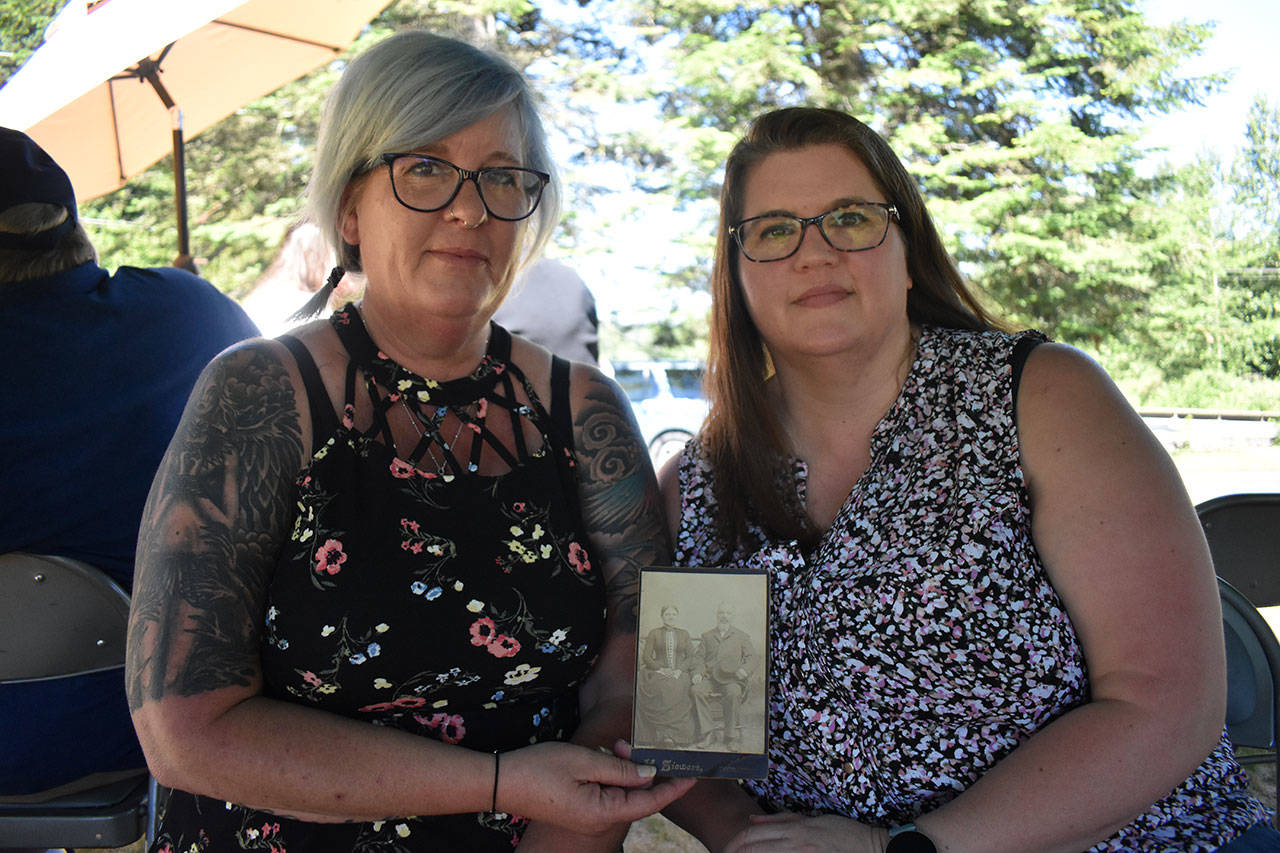It only took 135 years, but Daisey Kirtley is back with her family.
At least, her grave is. It was officially reunited Saturday with the Kirtley family gravesite at the Buckley Cemetery, during a ceremony that brought about 50 people to witness the historical reuniting of the Bonney Lake area family.
Among them were Daisey’s great-grandnieces Robyn Salo and Raynne Cech. (A third sister wasn’t able to make it to the ceremony that day.)
“It’s definitely interesting learning about the history of the family, and how far back we’ve gone,” Salo said. “It’s fun learning about this. This has always been my home. … It’s surreal.”
“It’s neat to see all the people who are so excited about it,” Cech added.
Born April 10, 1878, Daisey died just a month before her eighth birthday on March 13, 1886. Washington only became a state three years after her death.
Astoundingly, her grave showed up last year in Bonney Lake – triggering months of research into her history.
“When I think about the journey this little stone made to get here, to use an old phrase, it blows my mind,” Weeks Funeral Home outreach liaison Charmaine Jovanovich-Miller said in her welcoming speech to the crowd. “But then it makes me smile. Because it would never have happened if not for all the good people who didn’t know a girl named Daisey, had never met her … (and) stepped forward to help.”
Shane Riley, a ranger at the Army Corps of Engineers’ Mud Mountain Dam Park, did his own research on the grave and reached out to the sisters after learning of their familial connection to Daisey. He’d already been studying families in the area for his project on a series of interpretive panels, and recognized the name “Kirtley” when Daisey’s story first got out.
For Riley, “it’s fulfilling” to see the great-grandnieces reunited with Daisey.
“They had no idea, so what a great surprise for them to be part of something they were completely unaware of,” Riley said.
Daisey’s journey – at least, her gravestone’s – was anything but ordinary.
Her grave showed up in October last year in the woods near Bonney Lake. Nearby resident Dustin Baccetti, releasing a mouse that his cat had caught, stumbled upon it.
Baccetti shared some pictures in the Bonney Lake Community Group Facebook group, and the Greater Bonney Lake Historical Society soon became aware of the grave marker too. The Historical Society and sleuths from the Facebook group began parallel investigations into Daisey’s life, starting with the scant information from her grave marker. Riley, too, conducted his own research.
Clear from the outset was that the Kirtleys were one of the original pioneer families of the Plateau area, settling to grow hops in the Lake Tapps area in the late 19th century.
But it turns out the Kirtleys had been here decades before.
James’ brother Whitfield Kirtley joined three other men in 1953 to travel from Yelm in order to scout the Naches Trail through the Cascade Mountains, according to Riley’s research. War broke out between settlers and Native Americans in 1855, and Fort Henness was constructed for shelter in Grand Mound.
The Kirtley family were one of 20 families that likely had to take shelter in the fort for almost a year as war raged on, Riley said. James Kirtley, along with most of the other adult men, was enlisted into service in the Army.
After the war, the Kirtley family likely moved back to Summit, Missouri, Riley said, where Daisey was born, though records on exactly where they spent that time are conflicting.
Either way, decades later, they made their way to the Lake Tapps area.
James and Mary Kirtley settled at their pioneer homestead located at Lake Davis (later known as Kirtley Lake) in 1885 to grow hops, Foothills Historical Society treasurer Jean Contreras said. The Kirtley family took ownership of the land in 1890.
Around 1900, the family sold their farm to Westinghouse Electric and Manufacturing Company, which was purchasing property around Lake Tapps as part of the White River Project. The family moved to a new farm across from what is now Haugen’s Dairy Farms on Sumner Buckley Highway.
Roughly a decade later, the White River Project flooded the original family farm during the construction of a hydroelectric power plant fueled by water diverted to Lake Tapps. Four natural lakes – Crawford, Kirtley, Church and Tapps – were flooded to create the Lake Tapps reservoir. Daisey’s old home is now underwater just north of Tapps Island.
Mysteries still remain to be solved in Daisey’s story. The historians have not yet determined her cause of death, nor exactly how her grave made its journey to the woods in Bonney Lake. While they suspect she was buried at the old family farm, now underneath Lake Tapps, that detail hasn’t yet been confirmed either.
But at least one piece of the puzzle has now clicked into place.
“A lot has changed since 1886, but the loss of a child feels the same no matter what year you’re in,” Jovanovich-Miller said. “So today … it seems like a pretty happy ending to me.”


